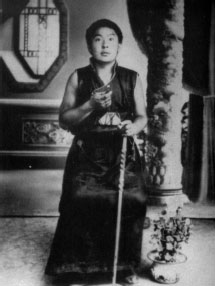 Khenpo Gangshar
Khenpo Gangshar
When Khenpo Gangshar was a young boy, he met the Shechen Kongtrul Rinpoche, one of the reincarnations of Jamgön Kongtrul Lodrö Thaye. The Shechen Kongtrul recognised him as an emanation of a great Indian master and said that he would become an exceptional person, so he should be well cared for. Few believed this however, because actually he was quite naughty and rough. They doubted any child so badly behaved could become someone exceptional. At some point however, his potential was awakened, and he began to study and practice the Dharma. He became quite learned and was appointed as a khenpo (master of studies) of Shechen Monastery. He also developed a very deep and strong meditation practice. Later, when he began to give his own particular instructions, which lead to really exceptional experiences, people recognised what an exceptional lama he was.
He taught Trungpa Rinpoche the Supreme Continuum and middle-way philosophy among other things. While teaching the Supreme Continuum, he fell ill and a verse came to him;
Within the first month, Zing zing zing!
Within the second, Ururu!
Within the third month, Sharara!
Within the fourth month, Trarara!
Within the fifth month, wails of Sharara!
Within the sixth, the Chinese shout So! will ring out.
Within the seventh, they’ll control the realm of Tibet.
If on the cusp of the fifth, seventh and sixth,
You do not go to a hidden land, delaying,
There is no doubt that you will be made Chinese.
His students said this sounded like a prophecy, but he said it was nothing. He did not think of himself as a great meditator or teacher. He did not see himself as having pure perception or being able to make prophecies, so he threw it into a fire, but the paper flew back out unharmed. This is how he made the prophecy. When the Chinese invaded Tibet, Trungpa Rinpoche was forced to flee in 1959, bringing the precious teachings West with him.
Five Pillars of The Longchen Foundation
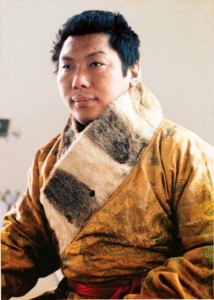
Chögyam Trungpa Rinpoche
Trungpa Rinpoche was born in 1940 in the province of Kham in Eastern Tibet. He was recognized as the eleventh incarnate teacher in the teaching lineage known as the Trungpa Tulkus. Trungpa Rinpoche was enthroned as Supreme Abbot of Surmang Monasteries and Governor of Surmang District. When he was eight years old, Rinpoche received ordination as a novice monk. In 1958, when he was 18 years old, he completed his studies, receiving the degrees of Chopon (doctor of divinity) and Khenpo (master of studies). As a Kagyu tulku, training was in meditation and philosophy, and the practice of traditional monastic disciplines, as well as the arts of calligraphy, thangka painting, and monastic dance. Trungpa Rinpoche received full monastic ordination. His primary teachers during his eighteen years of training in Tibet were Jamgon Kongtrul of Sechen and Khenpo Gangshar, great teachers from the Nyingma and Kagyu lineages respectively. When the Chinese invaded Tibet, Rinpoche fled to India in 1959. In the same year the Fourteenth Dalai Lama, His Holiness Tenzin Gyatso, appointed Rinpoche to serve as spiritual advisor at the Young Lamas Home School in Dalhousie, India.
Rinpoche came to England and 1963 which is when Rigdzin Shikpo encountered him for the first time. In 1964 Trunpa Rinpoche received a Spaulding Scholarship to Oxford University, where he studied comparative religion, philosophy, and fine arts. It is while he was living in North Oxford that he and Rigdzin Shikpo met amidst auspicious signs.
He took great interest in Japanese flower arranging, and received a degree from the Sogetsu School. In 1967, he founded Samye Ling Meditation Center in Dumfriesshire, Scotland. In 1969, Trungpa Rinpoche went to Bhutan to do a solitary retreat. This retreat was a turning point in his life, because soon after the retreat, he put aside his monastic robes, became a lay person, married a young Englishwoman, and moved to North America where he founded Vajradhatu, the Naropa Institute and The Nalanda Translation Committee. In 1976 he established the Shambhala Training Programme. Trungpa Rinpoche died in 1987, at the age of forty-seven.
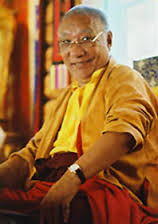
Khenpo Tsultrim Gyamtso Rinpoche
Khenpo Rinpoche was born in 1935 to a nomad family from Nangchen, Kham (eastern Tibet). He left home at an early age to train with Lama Zopa Tarchin, who was to become his root guru. After completing this early training, he lived the ascetic life of a yogi, wandering throughout Tibet and undertaking intensive, solitary retreats in caves and living in charnel grounds practicing Chöd. At Tsurphu Monastery, the historic seat of the Karma Kagyu lineage, Rinpoche continued his training with the lineage head, the 16th Gyalwa Karmapa, and other masters. After the communist invasion of Tibet, Khenpo Rinpoche fled to India in 1960 where he studied for the next nine years. During this period Rinpoche was honored by the sixteenth Karmapa, and named as an abbot (khenpo) of the Kagyu lineage.
When his studies were complete, he took an oral debate exam before a gathering of several thousand abbots, tulkus, teachers, and monks of the four major Buddhist orders of Tibetan Buddhism. The gathering was presided over by His Holiness the Dalai Lama. After the exam, he was awarded the degree of Geshe Lharampa.
Rinpoche has always placed great value on the songs of realization of Milarepa, such as those found in his One Hundred Thousand Songs, as well as those of all the siddha forebears of the earlier and later schools. Accordingly, he has uttered many vajra songs elucidating their intention. He has also independently composed innumerable vajra dohas that communicate the oral instructions.
He revitalized the tradition of practice related to the 3rd Karmapa, Rangjung Dorje’s Karma Nyingthig, the heart essence of the Karmapa,and imparted its experiential, pith instructions. In Bhutan, he established three retreat centers in the area of the royal residence at Kunga Rabten: one in 1988, called Drolma Chöling, one in 1998, called Ngön-ga Chöling, and one in 2001, called Kunzang Ngayab Chöling. In 1986, he founded the Marpa Institute for Translation and the Marpa Translation Committee. In 2000, Rinpoche established a retreat center in Yolmo Gangra in Nepal, at Tak Puk Senge Dzong, the tiger cave, lion fortress, a practice site of the lord Milarepa. In 2006, Rinpoche established Thegchok Ling nunnery near the Jarung Khashor stupa in Bodhnath.
Khenpo Rinpoche leads a truly simple, homeless life; he is a master of non-attachment. He has many times refused to accept property to build Buddhist centres and regularly gives away all of his money. Khenpo Rinpoche demonstrates the carefree life of a yogin, singing spontaneous songs of realisation wherever he goes, devoted only to the welfare of others. Since the deaths of Trungpa Rinpoche and Khyentse Rinpoche, Khenpo Rinpoche has been Rigdzin Shikpo’s main source of guidance and directed Rigdzin Shikpo’s three year retreat in Oxford. Following this, and in recognition of his realisation, Khenpo Rinpoche gave him the title Rigdzin Shikpo. Rigdzin means Knowledge Holder (vidyadhara in sanskrit) and Shikpo means beyond concepts.
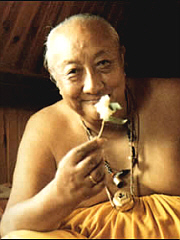
Dilgo Khyentse Rinpoche
His Holiness Dilgo Khyentse Rinpoche was born in 1910 in Denkhok Valley, eastern Tibet, to a family descended from the royal lineage of the ninth century King Trisong Detsen. While still in his mother’s womb, he was recognized by the great master Mipham Rinpoche as an extraordinary incarnation.
He was one of the last great masters to have completed his entire training in Tibet. When he left Tibet and went into exile, he travelled all over the Himalayas, India, southeast Asia, Europe and North America, transmitting and explaining the teachings to his many students. He was not only a principal holder of the Longchen Nyingthig lineage of Dzogchen, but a lineage holder of teachings from all schools of Tibetan Buddhism. This, together with his exemplary activity within the non-sectarian Rimé movement, meant that there was hardly a practitioner in the Himalayas who did not receive teachings from him. He was the master of masters. His Holiness the Dalai Lama considers him as his main teacher of Dzogchen and also became spiritual advisor to the royal family of Bhutan. He visited Britain in 1975 which is when he and Trungpa Rinpoche established the Longchen Foundation and authorised Rigdzin Shikpo as its spiritual director and lineage holder. Dilgo Khyentse Rinpoche passed away in Bhutan in 1991.
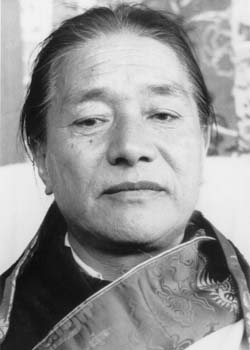
Dudjom Rinpoche
His Holiness Dudjom Rinpoche, Jikdral Yeshe Dorje, was one of the most outstanding yogins, scholars and meditation masters of recent times. After the flight of the Tibetans into exile, it was Dudjom Rinpoche who was the first master to be accorded the title of Supreme Head of the Nyingma School of Tibetan Buddhism, the oldest school introduced into Tibet in the 8th century by Guru Rinpoche. Born in 1904, into a noble family in the south-eastern Tibetan province of Pemakö, he was recognized as the incarnation of Dudjom Lingpa (1835-1904), a famous tertön or discoverer of concealed treasures (terma), particularly those related to the practice of Vajrakilaya.
Unique in having received the transmission of all the existing teachings of the immensely rich Nyingma tradition, Dudjom Rinpoche was especially renowned as a great tertön, whose termas are now widely taught and practised, and as the leading exponent of Dzogchen, the ultimate teaching within Tibetan Buddhism. Above all else, he was regarded as the living embodiment of Padmakara. Dudjom Rinpoche was the root teacher of many of today’s most prominent masters.
He was no less famous as an author and a meticulous scholar. His writings are celebrated for the encyclopaedic knowledge they display of all the traditional branches of Buddhist learning, including poetics, history, medicine, astrology and philosophy. A writer of inspirational poetry of compelling beauty, he had a special genius for expressing the meaning and realization of Dzogchen with a crystal-like lucidity. Amongst the most widely read of his works are the The Nyingma School of Tibetan Buddhism, Its Fundamentals and History, which he composed soon after his arrival in India as an exile. This is now available in English translation. This monumental history of the Nyingma School is a masterpiece which presents, for the first time, a great deal of new material on the development of Buddhism in Tibet, and will remain the authoritative work on the subject. At the invitation of His Holiness the Dalai Lama, Dudjom Rinpoche also wrote a history of Tibet. Another major part of his work was the revision, correction and editing of many ancient and modern texts, including the whole of the Canonical Teachings (kama) of the Nyingma School, a venture he began at the age of 74. His own private library contained the largest collection of precious manuscripts and books outside Tibet.
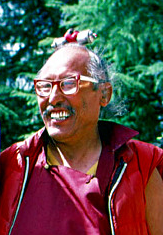
Yeshe Dorje Rinpoche
Yeshe Dorje Rinpoche was born on the fifteenth day, of the first month of the fire-tiger year (1926), and died at the age of 67. His birth place was Mar-Kham, which means, southern Kham, in Western Tibet. His Mother was called Sonam Drölma and his father was called Ögyen Dorje and they belonged to the Drompa Tsang clan who came from Lharong in Mar-Kham. They were a ngak’phang couple of the Nyingma school, and had two other sons and a daughter. This yogi and yogini held a family lineage as was common in the Nyingma school, and the lineage passed from father to son. The eldest son of the family was recognised as a tulku and became the abbot of a Do-ngak-Ling gompa, whilst Yeshe Dorje Rinpoche became the family lineage holder. The Drompa Tsang clan was famous for the ngakpas of their family lineage who had powers over the weather. They had been relied upon for hundreds of years for the prevention of hail, especially by farmers. Hail in Tibet could be unusually violent and destroy crops completely, so this service was very valuable.
Yeshe Dorje Rinpoche practised mainly as a ‘village ngakpa’, a Tantric shaman specialising in exorcism and weather control for the benefit of those amongst who he lived. He was a holder of the gö-kar-chang-lo, and was much loved by the Tibetan community in McLeod Ganj, in Northern India. In the later part of his life he became widely known as ‘the Dalai Lama’s weather-maker’, and traveled widely helping people with the vagaries of the climates they had to endure. In southern India the Tibetan communities suffered from drought, so he brought rain. In Manali he averted hail. Before his death in 1993 he had begun to travel frequently America where he performed exorcism in many places for the benefit of those with sickness and mental disturbances. He visited many of the centres established by HH Dudjom Rinpoche, gave instruction on Dudjom gTer-sar ngöndro. He also made some visits to the UK around this time. Yeshe Dorje Rinpoche was a master of Mahayoga – especially the practices of the Dudjom gTer-sar Tröma Nakmo. His main practice was Tröma gCod (Chöd) and it’s attendant rites, and his chöd drum and kangling were familiar implements to all those who visited him.
The Longchen Lineage Holder
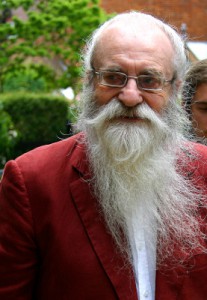
Rigdzin Shikpo
Born in 1935 in London, Rigdzin Shikpo’s life appears to be one of good karmic connections from a young age. Even as a child when he first heard the story of the Buddha, he felt an immediate attraction. From the point at which he decided to practice meditation as a young man, his path seems to have been unusually straightforward and free from obstacles. He has studied with teachers from all three Buddhist vehicles, Hinayana, Mahayana and Vajrayana, and has a deep practical knowledge of the entire tradition.
He began his formal training with a thorough grounding in Theravada Buddhism for nine years before meeting his root guru, Chögyam Trungpa Rinpoche in 1965 in Oxford amidst auspicious signs. He had previously received Mahayana teachings from Sangaraksita. The Chös group authorised by Trungpa Rinpoche in 1968 grew into the Longchen Foundation. Trungpa Rinpoche gave him extensive and detailed teachings for several years before leaving England for America. Rigdzin Shikpo continued with his study and practice here in England and in 1975 established the roots of what was to become the Longchen Foundation with Trungpa Rinpoche’s blessing. In 1975 the Longchen Foundation was established by Chögyam Trungpa Rinpoche and Dilgo Khyentse Rinpoche (on his first visit to Britain), both acknowledged as accomplished masters of the Kagyu-Nyingma and Nyingma traditions respectively, and as two of the great meditation masters of the 20th century. They appointed Rigdzin Shikpo as spiritual leader and entrusted him to realise their vision for the development and spread of the teachings.
As a westerner with many years experience in teaching Buddhism to other westerners, Rigdzin Shikpo has a way of communicating the essence of the teachings in an inspiring way which speaks directly to our needs and aspirations, without becoming distracted by the richness and complexity that can colour it through its various cultural expressions. A mathematician by training, he has a precise and penetrating intellect, enriched by a wide range of interests. He is a natural teacher, with a gift for imparting knowledge and resolving people’s difficulties. With a poet’s sensitivity to language, he has written fine translations from Tibetan as well as original poetry and Dharma texts.
Rinpoche works tirelessly for the benefit of beings and is devoted only to the welfare of others. His kindness and skill in means know no limits. We are truly fortunate if we can but catch a glimpse of such a teacher, let alone read what he has written or encounter him face to face.
Rigdzin Shikpo is Lineage Holder of the Longchen Foundation.
